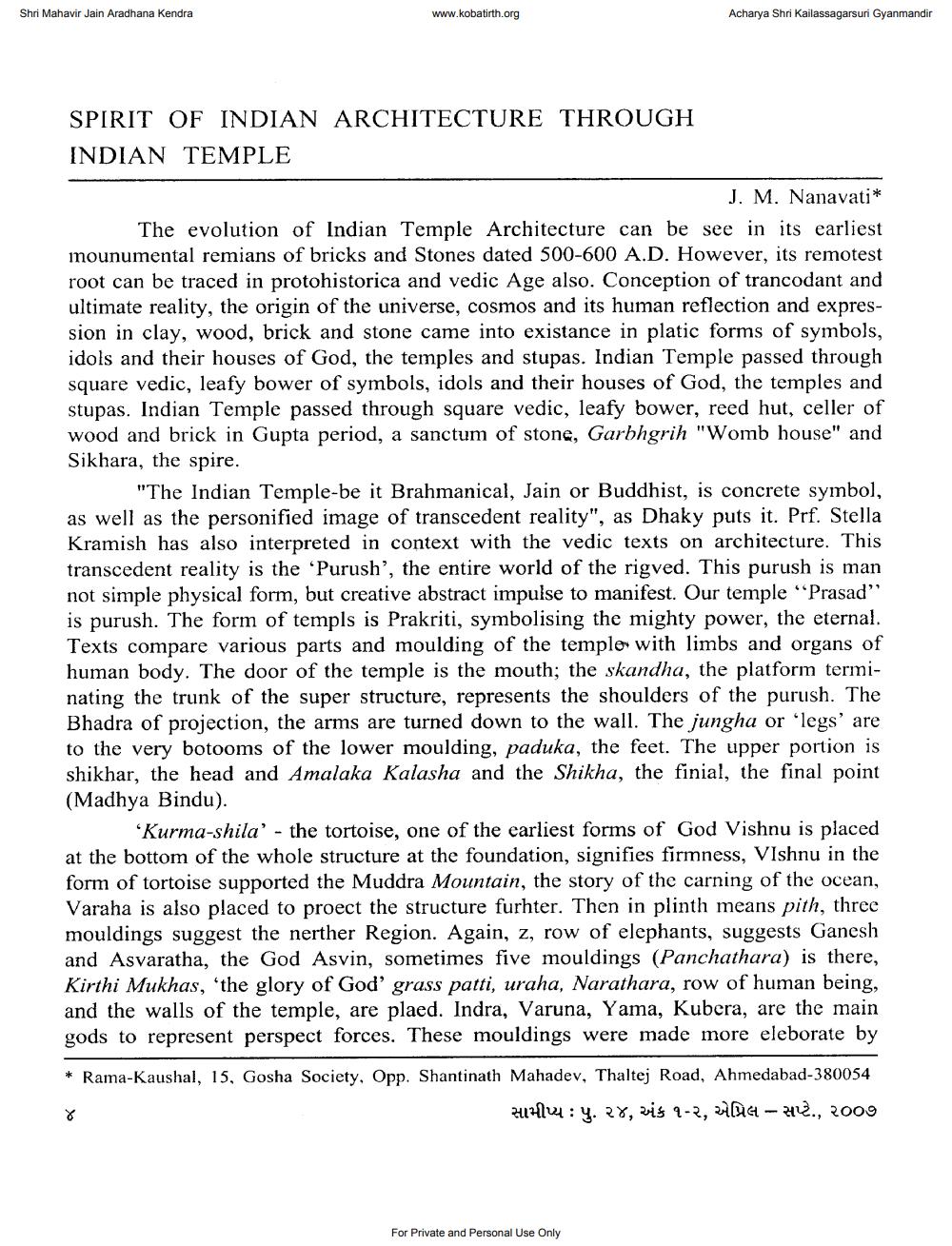________________
Shri Mahavir Jain Aradhana Kendra
www.kobatirth.org
Acharya Shri Kailassagarsuri Gyanmandir
SPIRIT OF INDIAN ARCHITECTURE THROUGH INDIAN TEMPLE
J. M. Nanavati* The evolution of Indian Temple Architecture can be see in its earliest mounumental remians of bricks and Stones dated 500-600 A.D. However, its remotest root can be traced in protohistorica and vedic Age also. Conception of trancodant and ultimate reality, the origin of the universe, cosmos and its human reflection and expression in clay, wood, brick and stone came into existance in platic forms of symbols, idols and their houses of God, the temples and stupas. Indian Temple passed through square vedic, leafy bower of symbols, idols and their houses of God, the temples and stupas. Indian Temple passed through square vedic, leafy bower, reed hut, celler of wood and brick in Gupta period, a sanctum of stone, Garbhgrih "Womb house" and Sikhara, the spire.
"The Indian Temple-be it Brahmanical, Jain or Buddhist, is concrete symbol, as well as the personified image of transcedent reality", as Dhaky puts it. Prf. Stella Kramish has also interpreted in context with the vedic texts on architecture. This transcedent reality is the 'Purush', the entire world of the rigved. This purush is man not simple physical form, but creative abstract impulse to manifest. Our temple “Prasad” is purush. The form of templs is Prakriti, symbolising the mighty power, the eternal. Texts compare various parts and moulding of the temple with limbs and organs of human body. The door of the temple is the mouth; the skandha, the platform terminating the trunk of the super structure, represents the shoulders of the purush. The Bhadra of projection, the arms are turned down to the wall. The jungha or 'legs' are to the very botooms of the lower moulding, paduka, the feet. The upper portion is shikhar, the head and Amalaka Kalasha and the Shikha, the finial, the final point (Madhya Bindu).
“Kurma-shila' - the tortoise, one of the earliest forms of God Vishnu is placed at the bottom of the whole structure at the foundation, signifies firmness, Vishnu in the form of tortoise supported the Muddra Mountain, the story of the carning of the ocean, Varaha is also placed to proect the structure furhter. Then in plinth means pith, three mouldings suggest the nerther Region. Again, z, row of elephants, suggests Ganesh and Asvaratha, the God Asvin, sometimes five mouldings (Panchathara) is there, Kirthi Mukhas, 'the glory of God' grass patti, uraha, Narathara, row of human being, and the walls of the temple, are plaed. Indra, Varuna, Yama, Kubera, are the main gods to represent perspect forces. These mouldings were made more eleborate by
* Rama-Kaushal, 15, Gosha Society, Opp. Shantinath Mahadev, Thaltej Road, Ahmedabad-380054
zu 14:. 27, wis 9-2, - ., 2009
For Private and Personal Use Only




